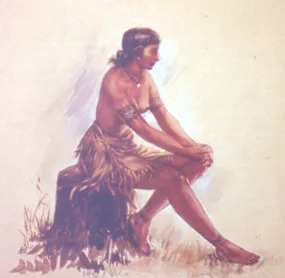As a historical romance author, I love the traditional romantic story of Pocahontas and John Smith falling in love. However, much of the research paints a different picture:
Pocahontas was the “most deare and wel-beloved” daughter of the most powerful Native American chief in Virginia. Her father Powhatan, aka as Wahunsenacawh, was the chief political leader for the Algonquians, around 15,000 people spread out in more than thirty villages stretching from the James River to the Potomac.
Her name was originally Matoaka, meaning flower between two rivers, but later changed to Pocahontas, meaning playful or wanton child.
Only 11 or 12 years old at the time she met John Smith, Pocahontas became his dear friend and a peace liaison between her people and the English. She helped save the lives of John Smith and the other early colonists at Jamestown. However, whether or not Smith’s live was actually in danger upon their famous first meeting is up for debate.
Smith was captured by some Powhatan warriors and shown off at several villages before being taken to the capital. There, he was presented to Powhatan. Suddenly, he was grabbed, and his head was forced down upon a stone. Several warriors stood over him with clubs, ready to strike, when Pocahontas threw her arms around him and placed her head over his. She then drew him up, and Powhatan welcomed him as a son, giving him a parcel of land for the English to settle on instead of the putrid water area of Jamestown.
Smith believed that the girl had saved his life. Further, research into Indian customs suggests that the traumatic event Smith experienced was an adoption ceremony.
Either way, there was a special bond between Smith and Pocahontas, and she cherished that relationship. As an 11 or 12 year old, she could have been infatuated with him or even in love. Girls in her tribe came of age around 13 years old and would often marry at age 13 or 14.
Over the next year, she helped save Smith and colonists from starvation by frequently bringing food and furs to the fort to trade with them. During her visits, she sought out Smith’s company. Her admiration for him was evident. On one occasion, her father sent her to negotiate the release of some Powhatan prisoners, and Smith said that he only agreed to release them for Pocahontas’s sake.
But she was also still a child at heart, during her visits to the fort, she enjoyed turning cartwheels with the boys: “she would follow and wheele some herself, naked as she was all the fort over” (naked because until Powhatan girls came of age, they wore very little clothing).
Smith may have viewed her as a child, but she left an indelible impression upon him. He found her striking and without peer: “a child of tenne yeares old, which not only for feature, countenance, and proportion much exceedeth any of the rest of his [Powhatan’s] people, but for wit, and spirit, the only Nonpariel of his Country.”
Pocahontas saved Smith’s life another time in 1609. A drought hit the region in the winter of 1608-1609, and relations between the English and her people worsened. Powhatan invited Smith and some of his men to his village to trade, but he snuck off with his family in middle of the night, planning to have Smith and his men killed. Risking her own life, Pocahontas traveled through the woods at night and snuck into Smith’s tent to warn him of the plan. It was the last time they saw each other that side of the Atlantic.
Powhatan moved his capital further away from the English settlement and didn’t allow Pocahontas to visit them anymore. Months later, Smith was seriously injured in a gun powder explosion and taken back to England for treatment. The colonists told Pocahontas that he was dead.
She grieved.
Pocahontas was a brave, young woman of character and unquenchable spirit who acted as a bridge between the Powhatan/Algonquians and the English. She treasured her relationship/friendship with John Smith.
(Check back next week to see learn about the man (men) she married and her reunion with Smith.)
Sources:
“Pocahontas: Her Life and Legend.” Historic Jamestown. National Park Service. https://www.nps.gov/jame/learn/historyculture/pocahontas-her-life-and-legend.htm#:~:text=After%20her%20capture%2C%20Pocahontas%20was,demands%20immediately%2C%20to%20open%20negotiations.
“Pocahontas.” Jamestown Rediscovery: Historic Jamestown. https://historicjamestowne.org/history/pocahontas/
(The drawing above is from the National Park Service.)


Thank you!
Wahunsenacawh, eh? I can’t even run my eyes over the whole word, let alone pronounce it.
Fun!
If you figure out how to pronounce it, Dave, please let me know:) I don’t have a clue. I should have asked one of the museum curators when I was at Jamestown.
My computer pronounces it wah-hen-senika.:) Great story.
I didn’t think about asking my computer. Thank you. I’m glad you enjoyed the story!
Interesting story, Sherry! Thank you for sharing!
Thank you for stopping by Patti:)
Hi Sherry, Never knew this part of their story. We lived in Midlothian, VA, for a short time, right next to the town/city of Powhatan. Love hearing this name again, and can’t wait to read the rest of the story next week!!
Thank you!! 🙂
I lived in VA for eleven years, but it took me going back on vacation for me to finally make it to Jamestown. But it was well worth the trip. I loved all of the history there.
Interesting. The things we don’t know.
I got to go to Jamestown last month and learned a lot of fascinating facts. Thank you for stopping by:)